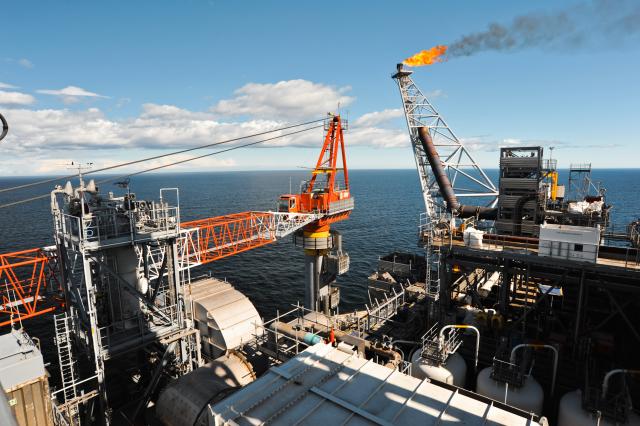
Flare system at an offshore production platform. (Source: Shutterstock.com)
Exxon Mobil Corp. reported positive quarterly and yearly 2022 results on higher Permian Basin and Guyana volumes despite divestments. The supermajor’s future production growth will be driven by the two assets, which combined could produce around 2.2 MMboe/d by 2027, the company said.
For the year, Guyana and Permian production both increased by more than 30%.
Exxon Mobil earnings reached $12.8 billion in fourth-quarter 2022 and $55.7 billion for the full year 2022, according to a Jan. 31 news release.
Though more than double 2021’s earnings of $23 billion, Exxon still faced major issues offsetting earnings in 2022, including asset impairments and higher European taxes, which were partly compensated by a one-time hit related to the Sakhalin-1 expropriation in Russia. In December, Exxon sued the EU over a new windfall tax.
Exxon Mobil also returned $30 billion to shareholders last year, including about $15 billion in dividends, company chairman and CEO Darren Woods said during a Jan. 31 earnings webcast. The company also increased its share buybacks to up to $35 billion cumulatively in 2023-2024.
Production in fourth-quarter 2022 was 3.8 MMboe/d, up over 100,000 boe/d compared to the third quarter. Despite production increases in the Permian and Guyana, and the start-up of the Coral LNG development in Mozambique, fourth quarter earnings were impacted by lower upstream oil and gas realizations, which fell 35% compared to the third quarter.
“For the first quarter 2023, the company anticipates flat volumes quarter over quarter, suggesting upside to both our projections and the Street, alongside higher planned maintenance across the broader downstream business,” Tudor, Pickering, Holt analyst Matt Murphy said in a Jan. 31 research report.
“We’ve continued to strengthen our industry-leading portfolio and increased production from high-return, advantaged assets in Guyana and the Permian,” Woods said.
The company’s planned capex of $23 billion to $25 billion in 2023 aims to underpin asset and product mix improvement, Woods said.
Permian production growth, zero routine flaring
Exxon’s Permian assets delivered on both the production and flaring fronts.
The Permian delivered record fourth quarter production of over 560,000 boe/d. Higher production in 2022 was due to the company capturing “the benefits of the strong market by liquidating the large inventory of drilled but uncompleted wells (DUCs) built during Covid,” Exxon senior vice president and CFO Kathy Mikells said during the webcast.
Permian production is expected to reach 600,000 boe/d in 2023, up 140,000 boe/d compared to 2021, and then 1 million boe/d by the end of 2027, Mikells said.
Permian growth in 2023 is in-line with forecasts revealed by Cowen analysts Jason Gabelman and Brandon Bingham. Exxon’s production forecast in 2027 is also higher than an earlier forecast of 800,000 boe/d, they wrote in a Jan. 31 research report.
Exxon’s Permian operated assets also achieved zero routine flaring in the fourth quarter. This goes in hand with the Irving, Texas-based company’s plans to reduce emissions and achieve net-zero Scope 1 and Scope 2 greenhouse gas emissions from its operated unconventional assets by 2030.
Exxon looks to achieve zero routine flaring across all its global upstream operated assets by 2030 in support of the World Bank’s Zero Routine Flaring Initiative, Woods said.
Guyana production continues to climb
Offshore Guyana, the company continues to follow its “design one, build many” philosophy.
An Exxon-led consortium that includes Hess Corp. and CNOOC has announced gross discovered recoverable resources of around 11 Bboe in the Stabroek Block.
RELATED
Hess Corp. Reports Fangtooth SE-1 Find, Sets 2023 Capex Budget at $3.7 Billion
A project management approach has allowed the company to deliver projects ahead of schedule while growing the resource base with 10 new discoveries in 2022 and a new find in the fourth quarter, Mikells said.
Exxon’s production from its first two Guyana developments, Liza 1 and Liza 2, averaged over 360,000 bbl/d in the fourth quarter and is expected to average about the same in 2023.
Production at the third development, Payara, with gross capacity of 220,000 bbl/d, is expected by year-end 2023 and ahead of schedule, executives said.
The development plan for the fourth development, Yellowtail with a gross capacity of 250,000 bbl/d, has been submitted to the Guyanese government. Production there could start up sometime in 2025. The fifth development, Uaru with a gross capacity of 250,000 bbl/d, could come online in 2026, Hess CEO John Hess revealed Jan. 24 during a company webcast.
“In total, we anticipate having six projects on line, with a capacity of more than 1.2 million barrels per day, by year-end 2027,” Mikells said.
Recommended Reading
Deepwater Roundup 2024: Americas
2024-04-23 - The final part of Hart Energy E&P’s Deepwater Roundup focuses on projects coming online in the Americas from 2023 until the end of the decade.
Ohio Utica’s Ascent Resources Credit Rep Rises on Production, Cash Flow
2024-04-23 - Ascent Resources received a positive outlook from Fitch Ratings as the company has grown into Ohio’s No. 1 gas and No. 2 Utica oil producer, according to state data.
Technip Energies Wins Marsa LNG Contract
2024-04-22 - Technip Energies contract, which will will cover the EPC of a natural gas liquefaction train for TotalEnergies, is valued between $532 million and $1.1 billion.
Galp Seeks to Sell Stake in Namibia Oilfield After Discovery, Sources Say
2024-04-22 - Portuguese oil company Galp Energia has launched the sale of half of its stake in an exploration block offshore Namibia.




